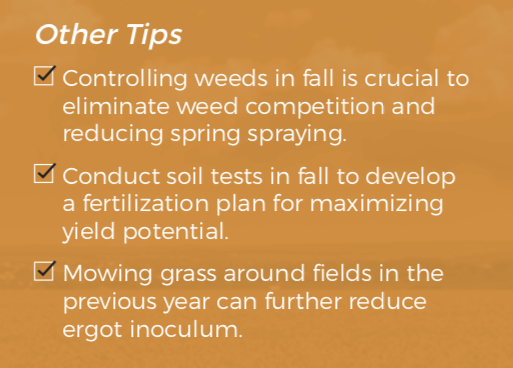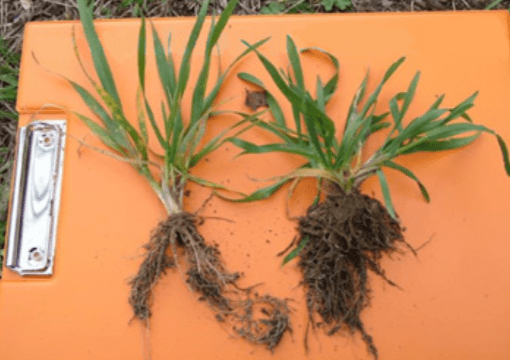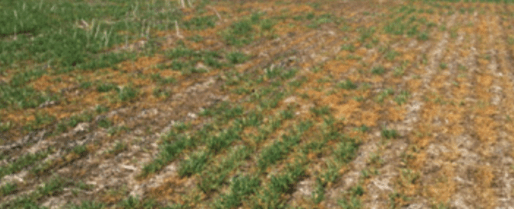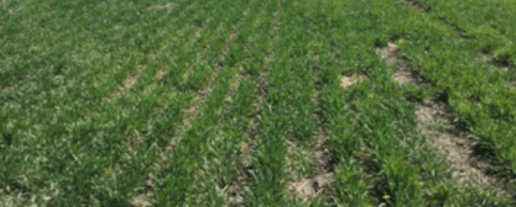Hybrid rye also helps manage your workload and helps with environmental management. Hybrid rye uses less water, nitrogen and crop protection than other cereals. It reduces soil erosion, improves soil health and minimizes wildlife disturbance.
Why Hybrid Fall Rye?
Big Benefits: Varieties like KWS Bono are high-yielding* and have great uniformity. Uniformity < straight- cutting option = time and $ savings.
Big Opportunity: Increased demand among the malting, ethanol, and feed markets.
Big Potential: Unlike crops grown for export, potential for producers to connect directly with end-use markets.
Field Selection and Preparation
Planting after canola provides good stubble and disease rotation from ergot and fusarium. (Choosing a field without straw cover requires more attention to seeding and emergence and requires good snow cover and/or moderate winter temperatures).


Seeding And Fall Establishment
Hybrid fall rye is different from other cereals be- cause it has a much more robust root system and develops significantly more tillers.
- Seed between August 15th and September 15th. Earlier seeding improves root and crown devel- opment for best winter survival and spring emer- gence. Preference is to establish 2 leaves with 2-4 tillers prior to winter onset.
- Seeding rate of 0.8 units/acre (800,000 viable seeds) to achieve 18.5 plants per square foot for best yields.
- Preferred seeding depth of 3⁄4 -1” with 7 – 8” row spacing. This will optimize emergence and even tillering which is key to ergot management, crop quality and maximum yields.
- Use tramlines if any ground spraying is planned. Mechanical damage from equipment tramping increases ergot infections.
- Apply starter fertilizer (some N and all PKS) as per soil test with the same placement as other cereals. Sulfur levels are important in hybrid fall rye pro- duction. The entire nitrogen plan may be applied in fall at seeding – if release can be planned for early activation.

Spring Scouting and Fertilization
- Scout your crop early in spring when average soil temperature exceeds 0°C.
- Early fertilizer application is critical as most yield potential is already determined by stem elongation (BBCH30).
- Apply spring nitrogen as soon as roots are starting to activate. Uproot plants and look for new white roots protruding from the crown. Do not rely solely on above ground appearance as waiting for above ground growth may result in applying fertilizer too late.
- Hybrid fall rye is 20% more efficient at utilizing nitrogen than wheat, so apply 20% less nitrogen than you would for similar wheat yields.


Pest Management
- Scout fields early!
- If in-crop spraying is required, use tramlines or spray aerially to minimize ergot production.
- Aim to spray when the crop is under 3 – 4” tall.
- A foliar spray of fungicide may be a good option if any early leaf diseases such as tan spot, Septoria, or rusts are a concern.
- Since there are no pesticide options for ergot control, limit ergot by avoiding fungicide spraying during anthesis. The exception – if there’s a high risk of fusarium head blight infection.
Harvesting
Hybrid fall rye is known for its uniformity, making straight-cutting an option.
- Are the days longer, warmer, and drier? This is the ideal time for easy harvesting.
- Use lower cylinder threshing speeds when com- bining. Manage concaves to minimize broken and peeled kernels.
- Rye is generally stored under 13.5% moisture. Harvesting at slightly higher moisture levels can reduce harvest damage and help achieve good grain quality. Careful though, moisture levels over 18% can adversely affect quality and falling number when dried.
- Pre-harvest glyphosate applications? Don’t even think about it. Pre-harvest glyphosate are not reg- istered in fall rye and could affect marketability of the crop.

